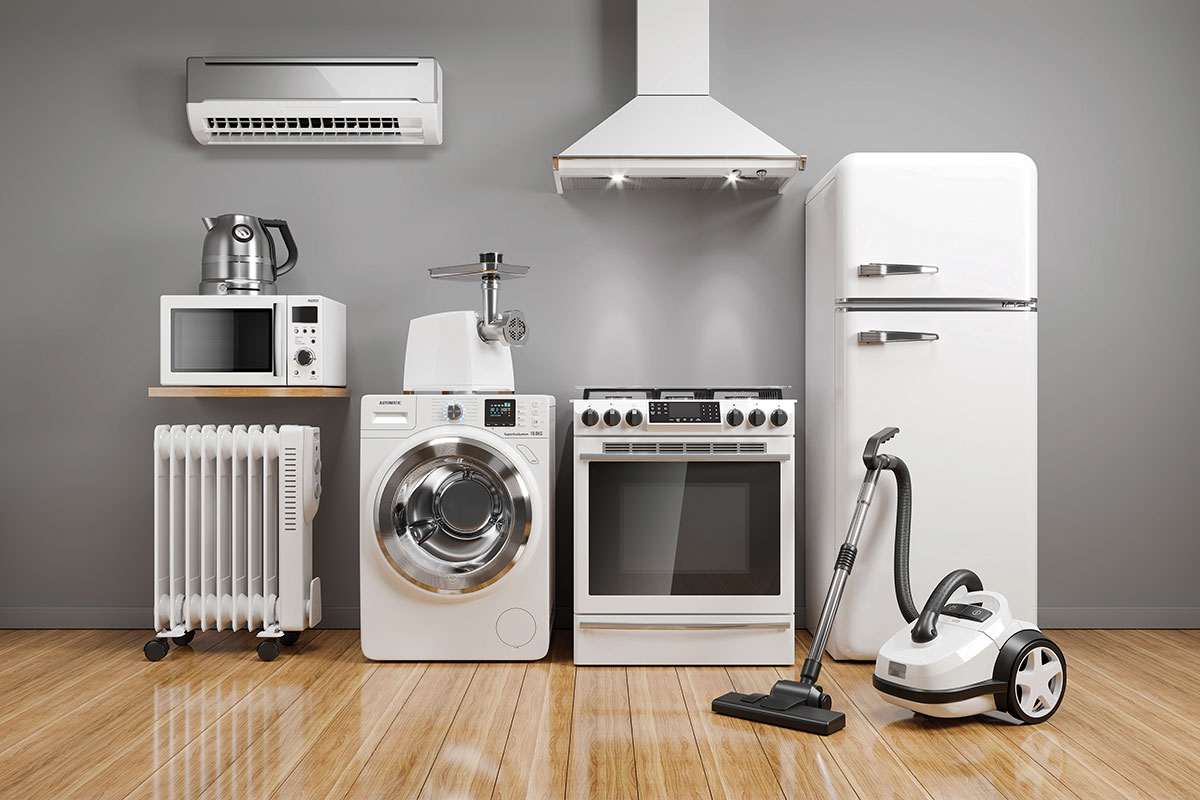When we think about appliances, many envision a washer, dryer, range, dishwasher, or microwave. Taking it a step further, what about the tie between safety and appliances? Some may simply view safety as an appliance that starts or turns on without an arc, spark, or malfunction. But there is more to safety and appliances than a breakdown or failure of the equipment itself. First, we should understand what an appliance is. The 2023 National Electrical Code® (NEC®) defines an appliance as utilization equipment, generally other than industrial, that is fastened in place, stationary, or portable; is normally built in a standardized size or type; and is installed or connected as a unit to perform one or more functions. Understanding this definition helps to grow our initial list of appliances significantly to include additional items, such as:
- Furnaces
- Air-conditioners
- Water coolers
- Tire inflation machines
- Automotive vacuum machines
- Sump pumps
So how does this affect the work of an inspector? What gets inspected for safety by the Authority Having Jurisdiction (AHJ)? Some might think there is nothing to inspect since appliances are normally one-piece units that are pre-wired at the factory, with integral safety features built in, that just get plugged into a receptacle. Quite the contrary. The real answer to what an AHJ needs to inspect for safety is – that it depends. What gets inspected depends on where the appliance is installed, the type of appliance, and how it is connected to electrical power.
Appliances typically come from the factory with installation instructions and often provide a couple of options for connecting to electrical power, such as a factory pre-installed cord, an aftermarket cord connected by the installer, or a permanent wiring connection. An initial critical piece for the AHJ is to verify if the appliance is listed. According to Section 422.6 of the NEC, appliances supplied by 50 volts or higher are required by to be listed. The installation instructions for the appliance are supplied to the qualified electrical testing laboratory to utilize as a part of their listing process. Instructions contain valuable information like a maintenance schedule, voltage requirements, ampacity rating, location rating (wet, damp, or dry), ground-fault circuit-interrupter (GFCI) requirements, and maximum overcurrent protection size. This is where the inspector can find additional appliance-specific information required for a safe installation, that may not be explicitly spelled out in the NEC.
Safety for appliances is not just about internal protection mechanisms that are installed at the factory, but also GFCI protection, arc-fault circuit-interrupter (AFCI) protection, branch circuit sizing, and overcurrent protection, which requires field verification by the AHJ. Section 422.5 covers the GFCI protection requirement for appliances rated at 150 volts to ground or less and 60 amperes or less, single- or 3-phase. This GFCI protection can be accomplished in several ways:
- Branch-circuit overcurrent device.
- Device or outlet within the supply circuit.
- Integral of the attachment plug.
- Within 12 inches of the attachment plug in the cord.
- Factory installed within the appliance.
The list above is specifically for GFCI protection of the appliances in Section 422.5(A), which may be accomplished outside of the branch circuit.
Section 210.8(A) requires that all 125-volt through 250-volt receptacles supplied by single-phase branch circuits rated at 150 volts or less to ground shall have GFCI protection for personnel in areas like:
- Garages and accessory buildings
- Outdoors
- Basements
- Kitchens
- Laundry areas
- Sinks- where the receptacle is within 6 feet from the top edge of the bowl or sink
Yes, the list includes outdoors and basements. Some dwelling units may have a second kitchen in the basement where GFCI protection is needed based on the NEC because it functions as a fully operable kitchen and is located within a basement. In warmer climates, you may find outdoor cooking areas for entertaining. Appliances on our list that are located in these applications would need verification that the appliance is actually suitable for a damp location, and they would also be required to have GFCI protection. In other words, when you have appliances in these areas that are cord-and-plug-connected, GFCI protection from the receptacle or breaker will satisfy the requirements listed in 422.5(B).
For spaces other than dwelling units, Section 210.8(B) outlines GFCI requirements for similar areas found in 210.8(A). But there are some that are different and specific to 210.8(B), like item (7), which covers GFCI conditions for areas with sinks where receptacles or cord-and-plug-connected fixed or stationary appliances are installed within 6 feet from the top inside edge of the bowl of the sink. In 210.8(A)(8), it only states receptacles and not appliances, as found in 210.8(B)(7). Some other similarities are 125-volt through 250-volt receptacles supplied by single-phase branch circuits rated 150 volts or less to ground. A difference is that 50 amperes or less and all receptacles being supplied by a three-phase branch circuit rated 150 volts or less to ground, and 100 amperes or less are specific to 210.8(B). It’s important to note that Sections 210.8(A) and (B) both deal with receptacles and not just the appliance, as found in 422.5(A).
GFCI protection is also required for branch circuits or outlets supplying specific appliances rated 150 volts or less to ground and 60 amperes or less, single- or 3-phase, according to 210.8(D). These include:
- Automotive vacuum machines
- Drinking water coolers and bottle fill stations
- High-pressure spray washing machines
- Tire inflation machines
- Vending Machines
- Sump pumps
- Dishwashers
- Electric Ranges, wall-mounted ovens, counter-mounted cooking units
- Clothes dryers
- Microwave ovens
This new list to 210.8(D) in the 2023 NEC is larger than the one found in 422.5(A) and is applicable to the branch circuit or outlet supplying power and not just the appliance itself. Previously, vending machines were required to be GFCI protected as an appliance. Commonly, they are installed after a final inspection, which makes verification of GFCI protection difficult if not impossible. Having GFCI protection installed in the branch circuit or outlet helps the AHJs walk away from the job site knowing that GFCI protection has been provided and verified.
Another safety product that may get overlooked, but impacts appliances is AFCI protection. If you are one of the many professionals who think that appliances are not required to have AFCI protection, you would be correct, they are not. But they may be protected by an AFCI device or breaker if they are a cord-and-plug-connected appliance, which are connected to a 120-volt, single-phase, 10-, 15-, and 20-ampere branch circuit in a dwelling unit supplying outlets or devices in areas like kitchens, laundry rooms, or similar areas. These areas require AFCI protection, according to 210.12(B), therefore the appliance would also be protected. Appliances covered in Article 422 are not necessarily required to have AFCI protection, but that does not mean they cannot have it.
Most appliances have labels attached that contain the following information: voltage, minimum branch-circuit conductor size, and the maximum overcurrent protective device (OCPD) allowed. If the label is missing or can’t be found, this information will typically be found in the installation instructions that came with the appliance. The OCPD has a significant role in safety, by protecting the branch-circuit conductors and the appliance, just like GFCI protection safeguards people. OCPD is outlined in 422.11 for appliances and must comply with section 240.4. This is where the electrical inspector needs the label, to ensure the OCPD does not exceed the maximum ampacity found on the label. Branch-circuit conductors are sized based on information provided by the label or installation instructions and must meet requirements set forth in 422.10.
As you can see, when it comes to appliances, there are several safety mechanisms required that will need to be verified by an electrical inspector. As electrical inspectors, we play a key role in helping reduce the risk of injuries and property damage from improperly protected appliances. Having a full understanding of how the requirements of the NEC relate to appliance installation and use is key in our role in providing safety for the end-user.
NFPA LiNK™ is a great resource for digital access to the NEC and the associated requirements for electric appliances, right at your fingertips while performing your inspection. Find out more by visiting nfpa.org/LiNK.
Important Notice: Any opinion expressed in this column (blog, article) is the personal opinion of the author and does not necessarily represent the official position of NFPA or its Technical Committees. In addition, this piece is neither intended nor should it be relied upon, to provide professional consultation or services.















Find Us on Socials